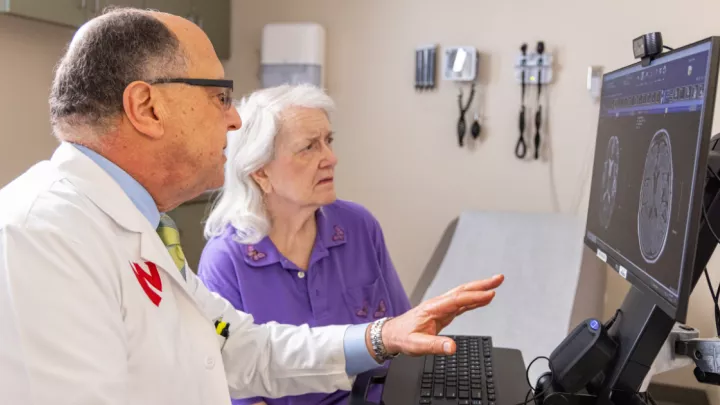What is an unruptured brain aneurysm, and how do you know if you have one?

Brain aneurysms are bulges at weak spots in one of the brain's blood vessels. The most common type is called a "berry" or saccular aneurysm. When this weakening causes the blood vessel wall to thin, it can leak or burst, causing a life-threatening brain hemorrhage.
An unruptured, or incidental, brain aneurysm is an area with a bulge or outpouching area in a blood vessel that has not ruptured. Most of these are found by chance during a scan for other medical issues. Typically, an unruptured brain aneurysm shows no apparent symptoms unless it grows large enough to press on the brain or nerves or cause a sudden rupture. Generally, the larger the aneurysm, the higher the risk of rupture.
The likelihood of having an unruptured brain aneurysm increases with age, affecting around 2% of the population overall and up to 5% of people over 65. According to the National Institute of Neurological Disorders and Stroke, up to 1 in 20 people in the United States will develop a brain aneurysm in their lifetime.
While many people live long lives with an unruptured brain aneurysm, if it bursts, blood bleeds around the brain, known as a subarachnoid hemorrhage. This type of hemorrhage can cause severe brain injury and/or death.
Read more about how a brain aneurysm is different from a stroke.
How do you know if you have an unruptured brain aneurysm?
Most unruptured brain aneurysms have no symptoms, so unless you have risk factors or your doctor finds one on a scan performed for another reason, chances are you won't know you have one.
However, suppose you are experiencing problems, and your doctor suspects an aneurysm. In that case, a scan (such as an MRI of the brain arteries often called an MRA) may be recommended with a referral to a vascular neurosurgeon.
Although infrequent, symptoms may include:
- Double vision or a dilated pupil.
- Pain above and behind the eye.
Unruptured brain aneurysms are not typically associated with seizures, cognitive impairment or memory loss. They are not known to go away on their own.
Are there treatment options for an unruptured brain aneurysm?
If an unruptured brain aneurysm is found on a scan, you will have options dependent upon various factors. A diagnosis doesn't necessarily mean you'll need surgery. Treatment is highly individualized, considering the risk of rupture versus treatment risk.
For some, the best treatment may be to observe the aneurysm over time with yearly imaging scans like a magnetic resonance angiogram or CT scan.
"While there are no absolutes, if we see that an aneurysm is growing on follow-up scans, that would be a red flag to consider therapy," says neurosurgeon William Thorell, MD. "In addition, frequent visits to the emergency room or clear symptoms of an unruptured aneurysm, such as double vision from the pressure, would also warrant a discussion of intervention."
Factors to consider will include:
- The size, location, growth and shape of the aneurysm.
- Your overall health, age, current or previous medical issues, and medications.
- Family history.
- Personal risk factors and preferences.
Your doctor will discuss the pros and cons of treatment and, if recommended, surgical options that are best for you.
What are the warning signs of a brain aneurysm rupture?
A sudden, severe "thunderclap" headache is a significant warning sign and is a medical emergency. Symptoms can also include nausea, vomiting, a stiff neck, and sudden loss of vision or consciousness. If this type of headache occurs, call 911 immediately.
"Almost always, a brain aneurysm rupture presents with a severe headache," adds Dr. Thorell. "It’s not just a severe headache, however. It is one that comes on suddenly. Many patients describe this event as the worst headache of their life. For those with frequent severe headaches such as migraines, it may not be the worst headache, but it's different than their typical headache. People with a history of migraines often know the signs and headache patterns. The key red flag signifying a possible ruptured brain aneurysm is the sudden onset of a different, very severe headache."
Read more about migraine-related headaches, when headaches may be a sign of a stroke or aneurysm, and what to do for each type of headache.
Brain aneurysm risk factors
Why brain aneurysms occur is not well understood, but there are risk factors to consider. Risk factors include:
- A significant family history. People with a strong family history of aneurysms in two or more blood relatives should be screened.
- Smoking.
- Uncontrolled high blood pressure.
- Atherosclerosis: A chronic inflammatory disease that occurs when plaque, a buildup of cholesterol, fat, blood cells, and other substances, builds up in the walls of arteries.
- Rarely, certain genetic conditions have been associated with a higher rate of brain aneurysms, including Ehlers-Danlos IV, Marfan's syndrome, neurofibromatosis NF1, and polycystic kidney disease.
"People with a strong family history or certain medical conditions associated with brain aneurysms are advised to undergo screening starting in their late 20s or 30s through their primary care doctor, with follow-up scans every 5 years," adds Dr. Thorell. "Patients with known aneurysms require more frequent, yearly monitoring and may choose to see us or do follow-ups with their primary doctor."
The bottom line: Know your risk factors and warning signs
An unruptured brain aneurysm requires careful monitoring and timely treatment, with a specific treatment approach tailored to the individual patient's risk factors and preferences. A ruptured brain aneurysm is a serious emergency. Don't wait – call 911 or go immediately to an emergency room.
Call 800.922.0000 to schedule an appointment with a primary care doctor or a brain aneurysm specialist.







